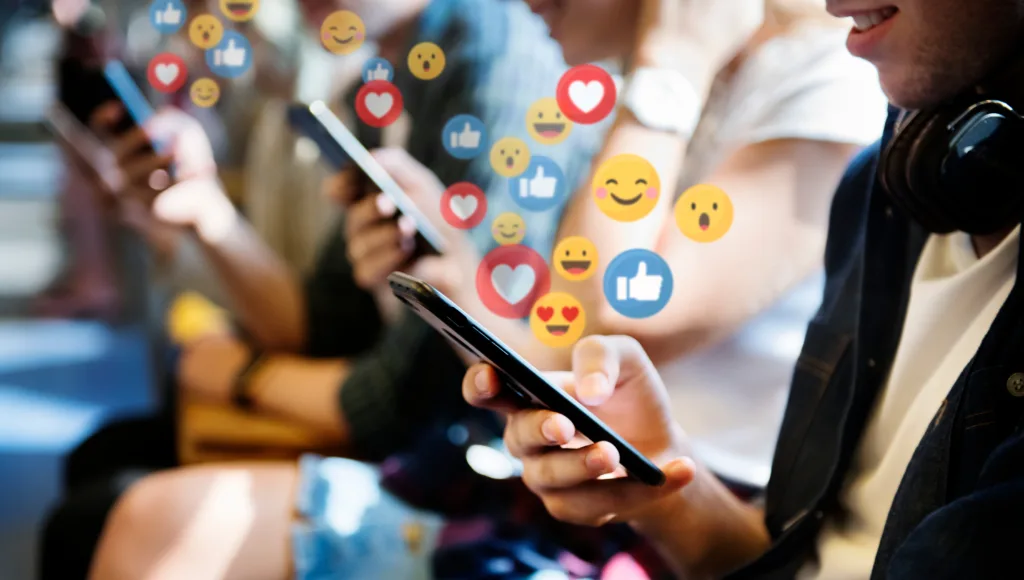A collaboration with Pamela Courtney

With the emergence of social media and communication between individuals using electronic devices (Computer-Mediated Communication or CMC), we have seen a revolution in personal interaction and communication. This rapid transformation has permanently reshaped the communication landscape for individuals and groups. And due to the immense popularity and exponential growth of major social media platforms like Facebook, Twitter, and Instagram, these changes have unfortunately resulted in a significant increase in conflicts, miscommunication, and misunderstandings.
This research paper aims to investigate some of the key factors that have contributed to the escalation of miscommunication in social media, specifically the absence of nonverbal cues, the utilization of slang, abbreviations, and emojis, and the speed and volume of which online communication occurs. Through an examination of these factors and their impact on misunderstandings, we can gain a better understanding of the challenges posed by communication with CMC and social media.
The absence of nonverbal cues in social media communication and CMC present a significant hurdle which is difficult to overcome and often leads to misunderstandings and challenges in effective online communication. In face-to-face interactions, nonverbal cues play a vital role in reinforcing or modifying the meaning of our spoken words. When it comes to CMC and social media, where communication primarily relies on typed text, these cues are absent, increasing the likelihood of misinterpretations. Kimberly A. Carter’s research emphasizes that “…no substitutes exist for nonverbal, face-to-face interaction…” (Carter) and that without these cues, the same message can be perceived as serious, insulting, or funny by different individuals. Carter further highlights that “…in the virtual world, …people tend to rely more and more on… typewritten ‘clues,’ (such as) icons, emoticons and flaming to transmit and decipher meaning” (Carter).
The difficulty in deciphering textual meaning, due to the lack of visual cues, can sometimes lead to misunderstandings and misinterpretations. These, in turn, can quickly escalate into conflicts, causing emotional distress and potentially doing damage to interpersonal relationships. To overcome the challenge of interpreting words without visual cues in CMC, individuals must recognize the limitations inherent to this mode of communication. Employing clear and unambiguous language, providing context, and actively seeking and providing feedback are key strategies that can enhance understanding and reduce the likelihood of misinterpretation. By adopting these approaches, individuals can navigate the complexities of CMC more effectively, fostering clearer and more meaningful communication in the digital realm.
Apart from the non-visual cues, the use of slang, abbreviations, and emojis also pose a significant challenge to effective communication on social media. Slang refers to informal and non-standard words or phrases that are commonly used within specific social groups or online communities. When slang is used in Computer-Mediated Communication, it can create confusion and misinterpretation for individuals unfamiliar with the terms. For instance, the popular slang term “yolo” (you only live once) conveys the idea of embracing life and living it to the fullest. For someone unfamiliar with the term it may be interpreted in an entirely different light, possibly associating it with a reckless or impulsive lifestyle. This misinterpretation comes from a lack of awareness regarding the specific context and connotations of the term. The absence of familiarity with the term’s intended usage and its underlying cultural references can lead to divergent understandings, potentially resulting in misunderstandings. This example demonstrates how the use of slang in CMC and social media can create confusion and misinterpretation, particularly for individuals who are not part of the specific social groups or online communities where the particular slang being used is prevalent.
Slang is not the only issue in online communication that can cause confusion and misinterpretation. Due to character and post length limitations imposed by some sites, abbreviations are often utilized to save both time and space. Abbreviations, like slang, can also lead to confusion when the abbreviations used are unfamiliar to the person reading them or they possess multiple meanings. A great example of this confusion is the abbreviation “LOL” for which there are as many as twelve different meanings. An example of two of them, that can often cause confusion, is that it could mean “laugh out loud” or “lots of love” depending on its usage. The fact that “LOL” has multiple meanings means that its interpretation can easily result in misunderstandings if the intended meaning is not explicitly clear. Aside from the confusion that abbreviations can cause, research done by Thotapally Anjaneyulu shines a light on the creative aspect of using abbreviations in CMC. In his findings, Anjaneyulu emphasizes that many abbreviations employed in digital communication showcase the ingenuity and resourcefulness of users. Abbreviations such as “n8” for “night” and “avlbl” for “available” demonstrate that these linguistic shortcuts arise not merely out of laziness or convenience but are the product of imaginative thinking.
Along with abbreviations, emojis have become an integral part of modern digital communication, serving as visual aids to express emotions and convey concepts in the absence of nonverbal cues. These graphic symbols play a significant role in compensating for the limitations of CMC, where the nuances of tone and facial expressions are not readily apparent.
When users of social media incorporate emojis into their messages, they are able to infuse their text-based communication with a sense of emotion, adding more depth and richness to their conversations. In a paper from 2018, Benjamin Weissman and Darren Tanner assert that “Emoticons, the predecessor to newer emojis, were originally regarded as simple markers of emotions but more recent approaches have posited that they can serve many complex pragmatic functions, a claim that is further bolstered by the recent explosion in number and usage frequency of emojis. Some recent research has investigated the ambiguity and potential for miscommunication that emojis carry, even when embedded in linguistic contexts” (Weissman). As Weissman and Tanner note in their research, it is important to remember that emojis are not immune to misinterpretation if their intended meaning is unclear or if they are used inappropriately.
The thumbs-up emoji serves as an exceptional example of how emojis, despite their intention to convey emotions and concepts, can be prone to misinterpretation in CMC. While this graphic symbol is commonly associated with agreement or approval, its meaning can become ambiguous and open to diverse interpretations within the context of digital communication. When used in CMC, where nonverbal cues and tone of voice are absent, emojis have emerged as a way to inject a sense of emotion and tone into text-based communications. The thumbs-up emoji, with its normally positive connotation, is used to express support, encouragement, or as a simple acknowledgment of a post or message. It’s usually interpreted as a friendly gesture, indicating agreement or appreciation of a user’s message.
The challenge lies in the fact that the meaning of an emoji is highly context-dependent and subjective and without the aid of vocal inflections or facial expressions, the intention behind the use of the thumbs-up emoji may not always be obvious. In certain situations where clarity or understanding is sought, such as when someone shares a personal struggle or seeks advice, the thumbs-up emoji could be perceived as dismissive or sarcastic instead of genuinely affirming. The confusion created by the sender’s intended meaning and the receiver’s interpretation can lead to hurt feelings, or even strained relationships.
Another factor that has helped to accelerate the amount of miscommunication and misunderstanding in social media and CMC is the speed, volume, and quantity of content that is generated daily on social media. In order to navigate this volume of content, individuals can take proactive steps to effectively manage their online presence. One such strategy is to be discerning in selecting the content they engage with, focusing on material that they find valuable and relevant, thus reducing what’s known as information overload. Researcher Ling Feng and her colleagues have found that “Information overload also shortens the visibility duration for popular messages. Because messages come to a user every day, new messages appearing above old messages, an information overload means any message, however popular, will rapidly lose its visibility, thus effectively shortening the [tau] value. Even extremely popular units of information content die quickly” (Feng). Even the most widely shared and celebrated pieces of information have a relatively brief shelf life. By recognizing the ephemeral nature of online content and employing strategic approaches to maximize visibility and engagement, individuals can overcome the complexities of information overload and effectively communicate their messages. The best way to do this is by taking the time to craft clear and coherent messages, by providing context when necessary, and by considering the potential impact of their words on others. By doing those things individuals can reduce the likelihood of their messages being misinterpreted or misunderstood by others.
In conclusion, the advent of social media and Computer-Mediated Communication has brought about a profound transformation in the way we communicate and interact with each other. The widespread adoption of platforms like Facebook, Twitter, and Instagram have permanently altered the communication landscape and the way we communicate. An unforeseen consequence of these changes in our communication methods has resulted in an increase in the amount of conflicts, miscommunication, and misunderstandings within these platforms communities. This research paper has delved into several of the factors that have contributed to this escalation of miscommunication and misunderstanding, including the absence of nonverbal cues, the use of slang, abbreviations, and emojis, and the ultra fast-paced nature of online communication. By examining these factors, we have gained valuable insights into the challenges posed by CMC and social media communication and how it has affected the way we now communicate with each other.
REFERENCES
Aguilar, Stephen J. “How to Deal Effectively with Misunderstandings and Conflict in Academe (Opinion).” Inside Higher Ed | Higher Education News, Events and Jobs, https://www.insidehighered.com/advice/2019/01/31/how-deal-effectively-misunderstandings-and-conflict-academe-opinion.
Anjaneyulu, Thotapally. “A glossary: usage abbreviations of mobile phone SMS.” ETC.: A Review of General Semantics, vol. 70, no. 2, Apr. 2013, pp. 141+. Gale Academic OneFile, link.gale.com/apps/doc/A347004730/AONE?u=mission_main&sid=bookmark-AONE&xid=ea801ecf. Accessed 4 May 2023.
Berger, Arthur Asa. 50 Ways to Understand Communication a Guided Tour of Key Ideas and Theorists in Communication, Media, and Culture. Rowman & Littlefield Publishers, 2006.
Carter, Kimberly A. “Type me how you feel: quasi-nonverbal cues in Computer-Mediated Communication. (An Internet Fieldtrip Report).” ETC.: A Review of General Semantics, vol. 60, no. 1, spring 2003, pp. 29+. Gale Academic OneFile, link.gale.com/apps/doc/A102966443/AONE?u=mission_main&sid=bookmark-AONE&xid=c24c147a. Accessed 4 May 2023.
Deepak Ouseph (MBA, MSc. Psychology). “The Danger of Confirmation Bias in Society & Social Media.” LinkedIn, https://www.linkedin.com/pulse/danger-confirmation-bias-society-social-media-deepak?trk=pulse-article#:~:text=The%20usage%20of%20’filter%20bubbles,while%20opposing%20viewpoints%20are%20excluded.
Feng L, Hu Y, Li B, Stanley HE, Havlin S, Braunstein LA (2015) Competing for Attention in Social Media under Information Overload Conditions. PLoS ONE 10(7): e0126090. https://doi.org/10.1371/journal.pone.0126090. Accessed 4 May 2023.
Jacobson, David. “Interpreting Instant Messaging: Context and Meaning in Computer-Mediated Communication.” Journal of Anthropological Research, vol. 63, no. 3, 2007, pp. 359–81. JSTOR, http://www.jstor.org/stable/20479429. Accessed 4 May 2023.
LEWIS, CYNTHIA, and BETTINA FABOS. “Instant Messaging, Literacies, and Social Identities.” Reading Research Quarterly, Received December 6, 2004; Accepted December 6, 2004, vol. 40, no. 4, 2005, pp. 470–501, https://doi.org/10.1598/RRQ.40.4.5.
Weissman, Benjamin, and Darren Tanner. “A Strong Wink between Verbal and Emoji-Based Irony: How the Brain Processes Ironic Emojis during Language Comprehension.” PLOS ONE, vol. 13, no. 8, 2018, https://doi.org/10.1371/journal.pone.0201727.
Vassallo, Philip. “BEWARE THE SEVEN DEADLY SINS OF TONE.” Etc., vol. 57, no. 1, 2000, pp. 100–14. EBSCO https://content.ebscohost.com/cds/retrieve?content=AQICAHjIloLM_J-oCztr2keYdV8f1ibHmDucods679W_YPnffAFifCDGIIcrsUszbw4eKCvoAAAA2TCB1gYJKoZIhvcNAQcGoIHIMIHFAgEAMIG_BgkqhkiG9w0BBwEwHgYJYIZIAWUDBAEuMBEEDHqQBaSwFnK_8pVgAwIBEICBkWCRJBvA2q4E47g_5OauIzFlIOb3uapiLGoMtyt3TtUFLkfluwk0lIU4Kq1kr7yARzLmgUaP0ZXmvujwEGt6L90WUh1evMYj5WuuhxsSBSrkp81E0IzF54x-uCKjoR37vm7z5QWOK7f-kdWRoHfLdO6BZhEdRT3cNTIfWqwmLtQaVrWHz2s1S8hJGPQ-OVdJsyM= Accessed 4 May 2023.
Zhou, Yanchun, and Yanhong Fan. “A sociolinguistic study of American slang.” Theory and Practice in Language Studies, vol. 3, no. 12, Dec. 2013, pp. 2209+. Gale Academic OneFile, link.gale.com/apps/doc/A356581765/AONE?u=mission_main&sid=bookmark-AONE&xid=7a418aab. Accessed 4 May 2023.
